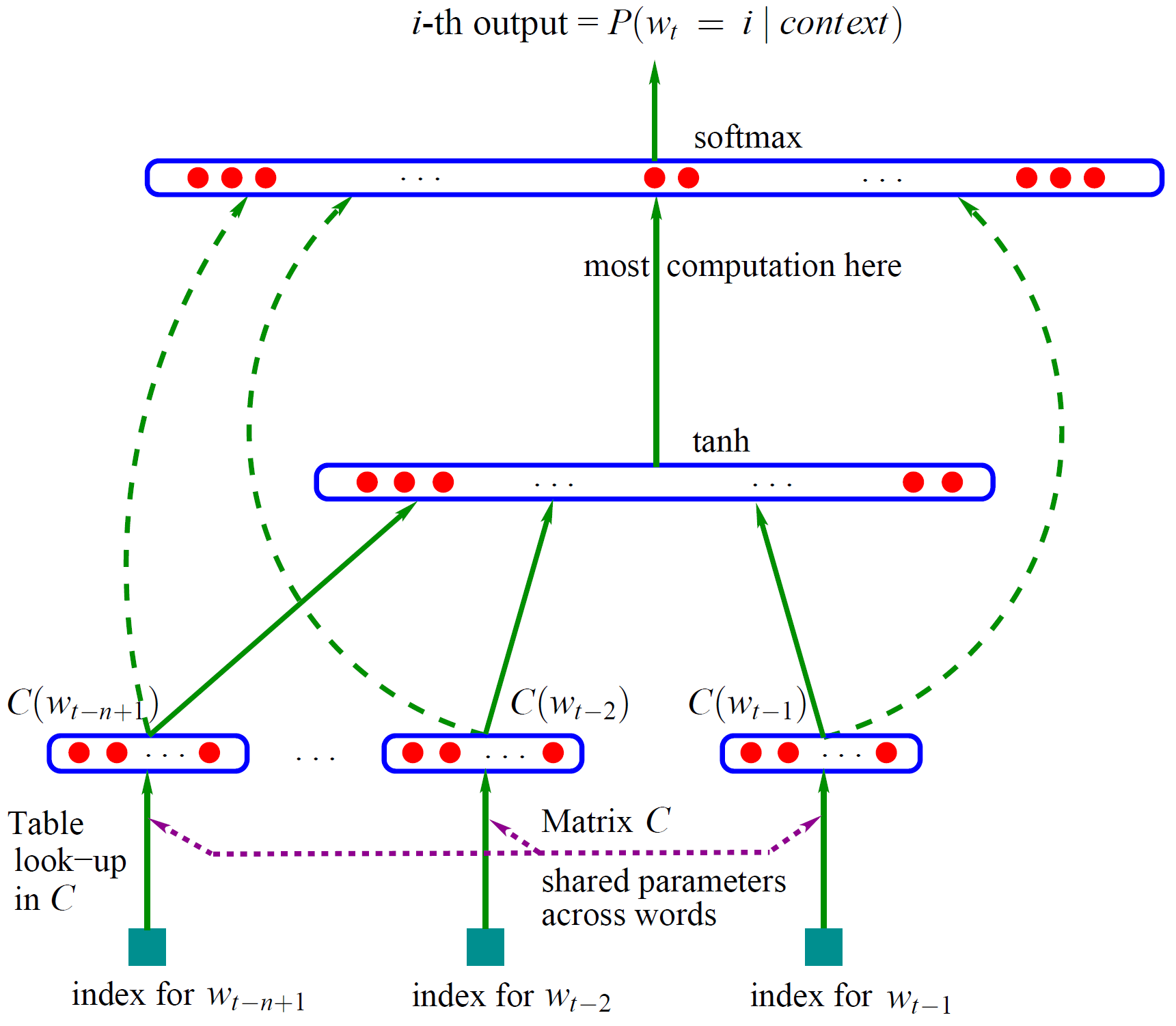摘要
本文介绍了语言模型,并介绍如何用MeCab和Keras实现一个日文的神经网络语言模型。(为什么是日文呢?纯属作者兴趣)
基于神经网络的语言模型
依据Wikepedia,语言模型的定义是“句子们的概率分布”。给定一个长度为m的句子,则可以有概率
由条件概率公式有
n-gram模型假设,第i个词语的概率分布只和前面固定的n个词有关(Markov性),那么就有
所以估计
的任务变成了估计
用传统的统计方法面临着
- 维度灾难(当n变大,存储空间不够)
- n元组并不会在语料库中全部出现
所以这里使用神经网络近似函数
神经网络方法解决了如上两个困难
- 当n变大,神经网络的参数以线性级别增长
- n元组虽然没有全部出现,但词向量可以捕捉到不同的词可能代表的相似的含义
一个传统的基于神经网络的模型结构如下图所示:
用MeCab实现日语分词
MeCab(めかぶ)是一款日语分词工具。Linux用户可以用如下指令安装MeCab:1
2sudo apt-get install mecab mecab-ipadic-utf8 libmecab-dev swig
pip install mecab-python3
MeCab可以对一个句子进行分词,并分析各词的词性。对于句子“すもももももももものうち”有1
2
3
4
5
6
7
8
9すもももももももものうち
すもも 名詞,一般,*,*,*,*,すもも,スモモ,スモモ
も 助詞,係助詞,*,*,*,*,も,モ,モ
もも 名詞,一般,*,*,*,*,もも,モモ,モモ
も 助詞,係助詞,*,*,*,*,も,モ,モ
もも 名詞,一般,*,*,*,*,もも,モモ,モモ
の 助詞,連体化,*,*,*,*,の,ノ,ノ
うち 名詞,非自立,副詞可能,*,*,*,うち,ウチ,ウチ
EOS
为了将分析的结果转化为分词结果,可用如下的mecab_to_text函数,则会输出“すもも も もも も もも の うち”。1
2
3
4
5
6
7
8
9
10
11
12
13
14
15
16
17
18
19
20
21
22
23
24
25
26
27def mecab_to_text(sentence_list):
"""
:param sentence_list: A list of sentences or one single sentence.
:return: A list of segmented sentences.
:note: Use mecab to segment a list of sentences or one single sentence in Japanese.
"""
import MeCab
mecab = MeCab.Tagger("-Ochasen")
single_flag = False
if isinstance(sentence_list, str):
sentence_list = [sentence_list]
single_flag = True
ret_list = []
for sentence in sentence_list:
text_list = []
m = mecab.parseToNode(sentence)
while m:
text_list.append(m.surface)
m = m.next
seg_sentence = " ".join(text_list).strip()
ret_list.append(seg_sentence)
if single_flag:
return ret_list[0]
return ret_list
模型构建
我们需要先构建我们的训练样本,语料库来自日语小说。对语料库中的句子用MeCab进行分词之后,用给定的窗宽k分割出训练集。训练集中的词和词向量进行对应为300维的向量。这样训练集中的每一个x(特征)对应一个(k-1)×300维的矩阵,每一个y(结果)对应一个one-hot的向量。
语料库
语料库是来自于网络上的日语小说,因为版权因素这里不提供下载。用什么样的小说并不会太影响我们后续的过程。在这里实现了load_text,make_word_dictionary,clear_dictionary;分别用来读入语料库,从分好词的语料库中生成词典,清理词典中在词向量里没有出现的词。1
2
3
4
5
6
7
8
9
10
11
12
13
14
15
16
17
18
19
20
21
22
23
24
25
26
27
28
29
30
31
32
33
34
35
36
37
38
39
40
41
42
43
44
45
46
47
48
49
50
51
52
53
54
55
56
57
58
59
60
61
62
63
64
65
66
67
68
69def load_text(use_length=-1, min_len=10):
start = time.clock()
japanese_text_path = "H:\\Work\\JapaneseModel\\Japanese_book\\"
text_list = []
if use_length == -1:
for file in os.listdir(japanese_text_path):
with open(japanese_text_path + file, 'r', encoding='utf-8') as f:
for line in f.readlines():
line_use = line.strip()
if len(line_use) > min_len:
text_list.append(line_use)
else:
counter = 0
for file in os.listdir(japanese_text_path):
with open(japanese_text_path + file, 'r', encoding='utf-8') as f:
for line in f.readlines():
line_use = line.strip()
if len(line_use) > min_len:
text_list.append(line_use)
counter += 1
if counter == use_length:
print("Japanese text loaded %d lines."%use_length)
elapsed = time.clock() - start
print("Time used:", round(elapsed, 3))
return text_list
print("Japanese text loaded all lines.")
elapsed = time.clock() - start
print("Time used:", round(elapsed, 3))
return text_list
def make_word_dictionary(split_text_list, lower_bound=100):
start = time.clock()
word_dictionary = dict()
for sentence in split_text_list:
sentence_use = sentence.split(" ")
for word in sentence_use:
if not word in word_dictionary:
word_dictionary[word] = 1
else:
word_dictionary[word] += 1
print("Word dictionary established.")
elapsed = time.clock() - start
print("Time used:", round(elapsed, 3))
if lower_bound > 0:
pop_list = []
for word in word_dictionary:
if word_dictionary[word] < lower_bound:
pop_list.append(word)
for word in pop_list:
word_dictionary.pop(word)
word_list = []
for word in word_dictionary:
word_list.append(word)
return word_list
def clear_dictionary(dictionary, embedding_dictionary):
ret_list = []
for word in dictionary:
if word in embedding_dictionary:
ret_list.append(word)
return ret_list
实现了这几个函数以后,就可以用如下的方式读入语料库。1
2
3
4japanese_text = load_text(use_text_length)
split_japanese_text = mecab_to_text(japanese_text)
dictionary = make_word_dictionary(split_japanese_text, lower_bound=10)
dictionary = clear_dictionary(dictionary, embeddings_index)
词向量
我们使用facebook在fastText项目中预训练好的日语300维词向量,下载地址点击这里。因为该文件的第一行保存了词向量文件的信息,你应该手动删除该行,然后用load_embedding函数来读取词向量。1
2
3
4
5
6
7
8
9
10
11
12
13
14
15
16
17def load_embedding():
start = time.clock()
"""
Total 2000000 words in this embedding file, 300-d. It is float16 type.
The first line is "2000000 300".
You should delete this line.
"""
EMBEDDING_FILE = 'H:\\Work\\cc.ja.300.vec'
def get_coefs(word, *arr): return word, np.asarray(arr, dtype='float16')
embeddings_index = dict(get_coefs(*o.strip().split(" ")) for o in open(EMBEDDING_FILE, 'r', encoding="utf-8"))
elapsed = time.clock() - start
print("Word vectors loaded.")
print("Time used:", round(elapsed, 3))
return embeddings_index
生成训练集
假设我们的窗宽为k,那么我们的训练集由k-1个词组成x_train,由之后连接的词组成y_train。如果k=3,我们语料库中的一个句子为“a bb ccc d”, 其中a、bb、ccc、d分别是4个词。那么我们将这个句子前面连接k-1=2个“space”,结尾连接一个“eol”,扩充为“space space a bb ccc d eof”。这样可以得到如下的训练样本:
| x1 | x2 | y |
|---|---|---|
| space | space | a |
| space | a | bb |
| a | bb | ccc |
| bb | ccc | d |
| ccc | d | eol |
generate_train函数实现了上述生成训练集的算法1
2
3
4
5
6
7
8
9
10
11
12
13
14def generate_train(window, end_index, text_seq):
prefix = [0] * (window - 1)
suffix = [end_index]
x_list = []
y_list = []
for seq in text_seq:
if len(seq) > 1:
seq_use = prefix + seq + suffix
# print(seq_use)
for i in range(len(seq_use) - window + 1):
x_list.append(seq_use[i: i + window - 1])
y_list.append(seq_use[i + window - 1])
# print(seq_use[i: i + window])
return x_list, y_list
构建神经网络模型
和传统的神经网络语言模型有所不同:先将x映射为词向量,连接双层BiLSTM作为隐藏层,再连接一个Softmax来预测下一个词是什么。在Keras中,实现BiLSTM非常容易。因为CuDNNLSTM的实现比LSTM要快很多,推荐安装cudnn来使用这个函数。加入了一些Dropout层来避免过拟合。1
2
3
4
5
6
7
8
9
10
11
12
13
14
15
16
17
18
19
20
21
22# Model
inp = Input(shape=(window - 1,))
x = Embedding(nb_words, 300, trainable = True, weights=[embedding_matrix])(inp)
x = Bidirectional(CuDNNLSTM(128, return_sequences=True))(x)
x = Dropout(0.1)(x)
x = Bidirectional(CuDNNLSTM(128, return_sequences=False))(x)
x = Dropout(0.1)(x)
x = Dense(128, activation="relu")(x)
x = Dropout(0.1)(x)
x = Dense(nb_words, activation="softmax")(x)
model = Model(inputs=inp, outputs=x)
opt = keras.optimizers.Adam(lr=0.001, beta_1=0.9, beta_2=0.999,
epsilon=None, decay=0.0, amsgrad=False)
model.compile(loss='categorical_crossentropy',
optimizer=opt, metrics=['accuracy'])
history = LossHistory()
epoch_nb = 80 # 40 is enough
batch = 64
model.fit(x_train, y_train, batch_size=batch, epochs=epoch_nb, verbose=1,
validation_data=(x_test, y_test), callbacks=[history])
随机生成句子
用predict_random_sentence函数来生成随机句子,其中的reverse_index保存了从语料库生成的词典中的词和序号的一一对应。若将[0,0,0,0]更改为其他数字,即可生成给定开头的句子。1
2
3
4
5
6
7
8
9
10def predict_random_sentence(new=[0] * (window - 1)):
sentence = reverse_index[new[0]] + reverse_index[new[1]] + reverse_index[new[2]] + reverse_index[new[3]]
while new[-1] != end_index:
prob = model.predict(np.asarray([new]))[0]
new_predict = int(random.choices(word_ind, weights=prob)[0])
sentence += reverse_index[new_predict]
new = new[1:] + [new_predict]
return sentence
predict_random_sentence([0,0,0,0])
保存模型
保存模型到本地,以后就可以直接调用,避免重复训练。上文中提到的tokenizer和神经网络模型都需要保存。1
2
3with open("../result/tokenizer.pkl", "wb") as handle:
pickle.dump(tokenizer, handle, protocol=pickle.HIGHEST_PROTOCOL)
model.save('../model/language_model.model')
效果展示
我们训练了80个epoch,使用了20000句话进行训练,选择的窗宽为5。以下是从日文语言模型中随机生成的一些句子。1
2
3
4
5
6
7
8'「なんだろう。僕が仕事を休みになり、でもまあ……見てた」'
'アグライアはグラスをじっと見つめた。'
'それにしても、それを使って、ジークをから表情になって猫のように《さ》がを受けた。'
'森そうだ、そんなことか」'
'真剣で命をように、そのの人は、辻宮氏はだいたい邸にてあげた《と?》みをうとした。「そんな顔だって今?」'
'佳澄ちゃんが……俺とさっきに言わせて下さい。'
'沙耶「まあ、沙耶ねえ先に戻ることにになってきます?」'
'「最近はどうしてそういうつもりじゃないでしょうね」'
简单的翻译一下生成的句子(日语水平比较烂,可能翻译错了)1
2
3
4
5
6
7
8'怎么说呢。我虽然下班了,但还是……看到了'
'Agria凝视着玻璃杯'
'即使如此,使用它,Sieg看来像猫一样的表情接受了さ'
'像树林啊,是这样吗'
这句话实在不太通顺……
'佳澄酱,请给我说下刚才的事情'
'沙耶:“嘛,沙耶先回去了啊?”'
'最近为什么不打算这样做了呢'
总体来说,该语言模型可以生成出一些通顺的话语。以上都是从空句子开始生成的,也可以改变生成句子的开头。
